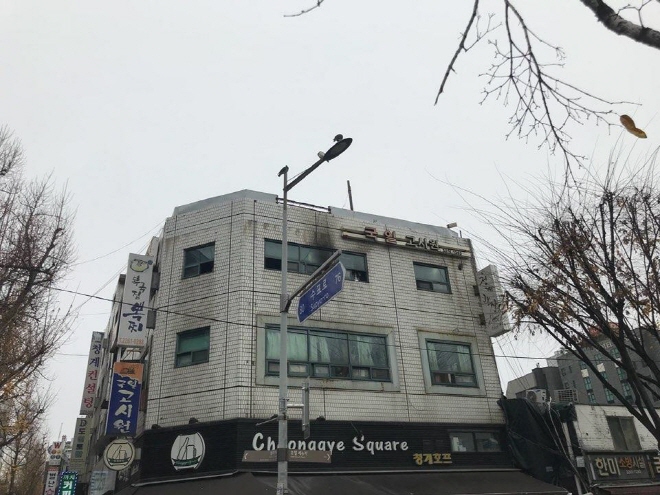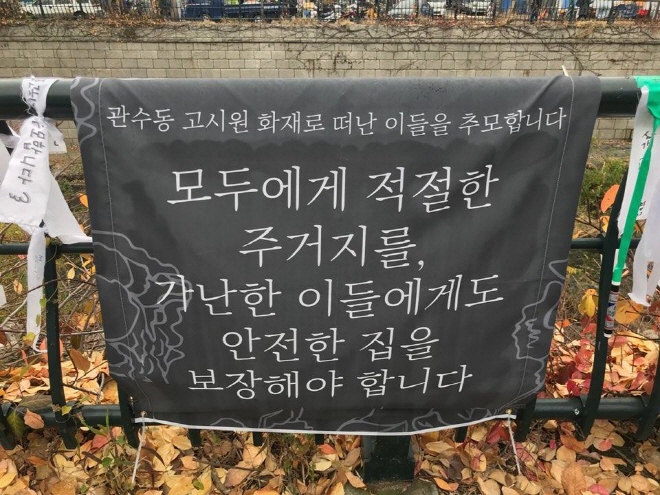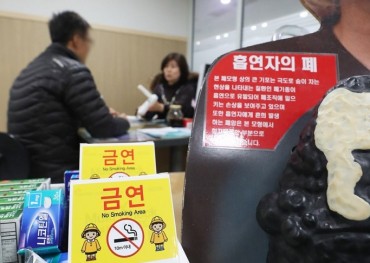
A low-cost boarding housing facility — commonly referred to as a “goshiwon” in Korean and literally translated to exam room — which occupied the second and third floors of an old and dilapidated building in Jongno Ward in downtown Seoul. A fire killed seven people and injured 11 others on Nov. 9. (Yonhap)
SEOUL, Nov. 23 (Korea Bizwire) — A 34-year-old mail delivery man, surnamed Cho, had lived in a 6.6-square-meter room with no windows and walls that were so thin that he could literally hear every word and every move of more than 20 tenants on the same floor.
Cho was among seven victims of a fire on Nov. 9 that broke out at a low-cost boarding housing facility — commonly referred to as a “goshiwon” in Korean and literally translated to exam room — which occupied the second and third floors of the old and dilapidated building in Jongno Ward in downtown Seoul.
Goshiwon is a unique form of dormitory-style single housing facility in South Korea that first appeared in the late 1970s, mostly near universities in Seoul. The facility provided cheap accommodation, mostly with sizes between 3 and 6 square meters, for students preparing for state-run exams to be lawyers or senior government officials.
The rooms, which are smaller than a typical studio apartment, are usually equipped with a small bed and a study desk so that students can literally isolate themselves from friends and society at large and concentrate on their studies. These housing facilities usually offer shared bathrooms and kitchens.
Goshiwon, once viewed as a means for intensive studying, have over the years become alternative housing for a variety of people who just cannot afford to pay for conventional forms of housing due to skyrocketing rental costs brought on by steady economic growth and rises in overall real estate prices, particularly in cities.
Most of the tenants living in the goshiwon in Jongno Ward also were unemployed or contract workers, and those killed or injured were aged between 50 and late 70, and barely spoke with each other. There were no university students actually preparing for an exam at the facility.
“I would not call this place a home,” said a 64-year-old man who owns a little shop right in front of the goshiwon building. “The people who were living here before mostly were unemployed who barely left their rooms or mingled with others.”
These facilities are popular among low-income earners as the rooms cost between 200,000 won and 300,000 won (US$176-265) a month, much cheaper than other one-room apartments. Also, goshiwon do not require expensive rental deposits and other utility fees, unlike the traditional rental housing systems.
A typical studio apartment, sized between 20 and 30 square meters, in the same district requires at least 100 million won, for a two-year “jeonse” contract. Jeonse is a home rental arrangement unique to South Korea, where tenants pay a deposit instead of paying monthly fees and landlords return the deposit when the lease expires.
“I would have bought my son an apartment somewhere or provided deposits for jeonse,” Cho’s father told reporters right after his son’s funeral, adding that goshiwon would not have been an option if he had savings or wealthy parents.

A sign left by a civic group, reading, “Everyone deserves an appropriate living space and even poor people should be guaranteed safe housing.” (Yonhap)
According to government data, the number of goshiwon has increased in recent years, with nearly 80 percent located in Seoul and the surrounding Gyeonggi Province. The number came to 5,940 in Seoul and 2,984 in Gyeonggi Province last year.
Goshiwon in recent years have also appeared in upscale districts, such as Chungdamdong and Dokokdong in southern Seoul, that are providing renovated rooms in an expensive area at the cost of around 400,000 won to 600,000 won per month. Most of the tenants are working people in their 20s and 30s who cannot either afford deposits or are saving for marriage.
Kim Sung-bong, a 32-year-old who works at a large construction firm, says he lives at a goshiwon in the downtown Seollung area as he has not saved up enough to pay for deposits for larger accommodations.
“I have been looking for a job for nearly three years and was just employed earlier this year,” Kim said. “I thought I would be able to leave this place as I have been living in other goshiwon for the last 10 years, but I may have to stay a little longer.”
Experts say that the government should craft a long-term policy that focuses on providing adequate living space for low-income earners or unemployed people so that they can be guaranteed minimum living standards.
“Most of the lowest-income earners cannot afford housing prices and are exposed to the dangers that took the lives in the recent fire….The government should open its eyes to the reality that some people have no choice but to live there despite the inherent risks and inconvenience,” Kim Yoon-young, a civic activist, said, also citing safety issues at goshiwon.
Experts have long pointed out that goshiwon can become fire hazards as some do not follow safety regulations and are overlooked by safety inspectors. Some owners have even take the step of illegally renovating the rooms and adding more partitions to accommodate more tenants.
An investigation showed that there were no sprinklers in the goshiwon in Jongno.
(Yonhap)






